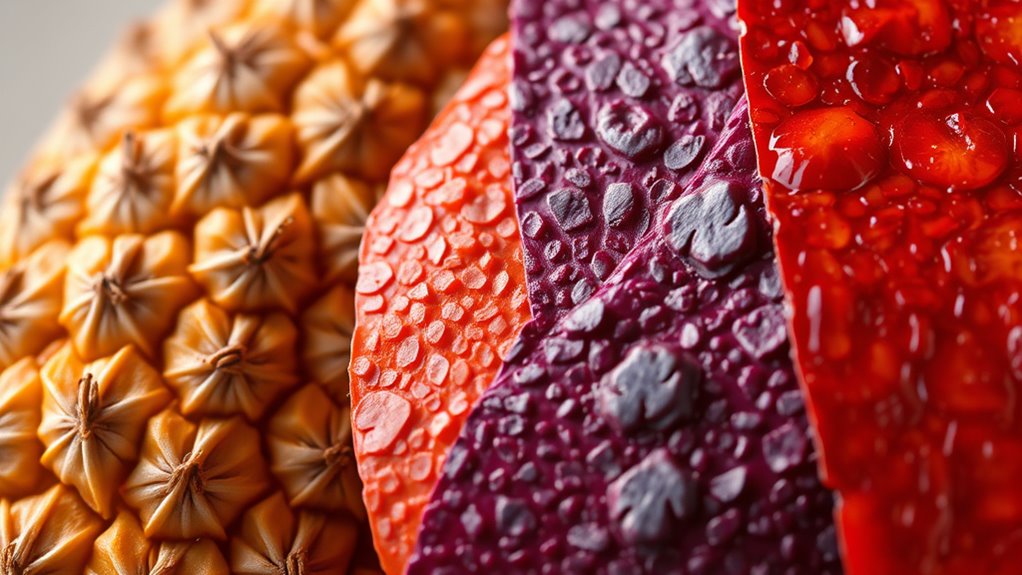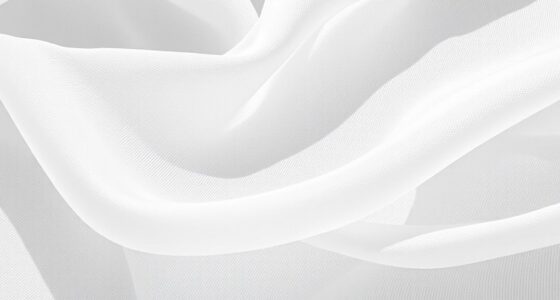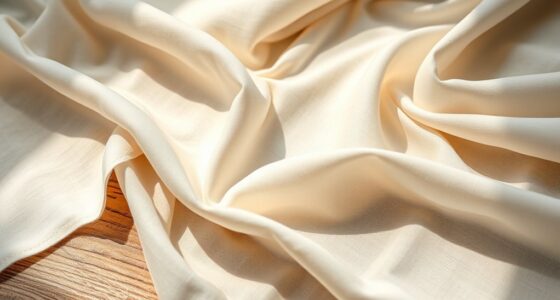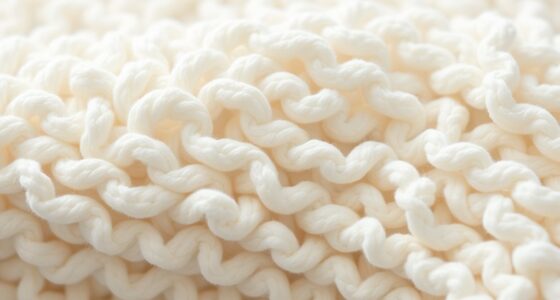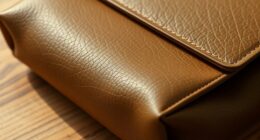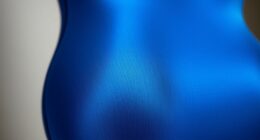Piñatex and fruit leathers from pineapple leaves are innovative, eco-friendly fabrics made from natural fibers that would otherwise be waste. By transforming pineapple leaf fibers into durable, leather-like materials, these textiles reduce environmental impact, save water and energy, and avoid harmful chemicals. They’re versatile for clothing, accessories, and home decor, inspiring sustainable design. To discover how these materials are shaping a greener future in fashion and beyond, keep exploring their exciting potential.
Key Takeaways
- Piñatex is a sustainable textile made from pineapple leaf fibers, offering an eco-friendly alternative to traditional leather.
- The production process extracts and processes pineapple leaves, transforming agricultural waste into durable, stylish fabrics.
- Pineapple leaf fabrics reduce water and chemical use, supporting environmentally responsible fashion and minimizing ecological impact.
- These versatile materials are used in clothing, accessories, footwear, and home decor, promoting sustainable design solutions.
- Utilizing pineapple leaves for fabric production exemplifies innovative eco-conscious practices, turning waste into valuable, fashionable products.
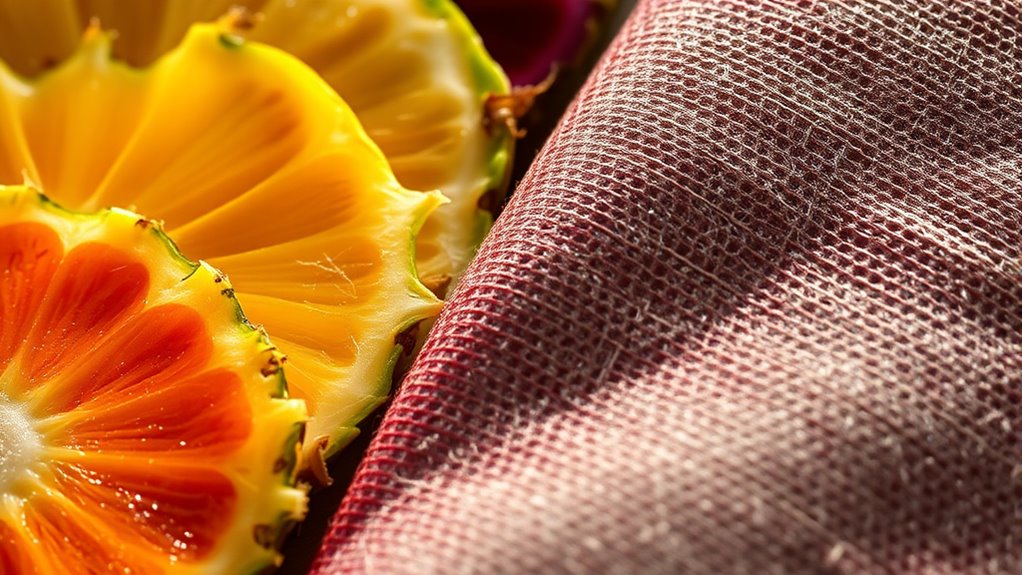
Have you ever considered turning pineapple leaves into fabric? It’s a fascinating idea that highlights the potential of sustainable sourcing and eco friendly innovation. Traditionally, pineapple leaves are discarded as agricultural waste after harvest, but now, companies are transforming these leftovers into valuable textiles. This shift not only reduces waste but also creates a new resource for fashion and design. By harnessing the natural fibers of pineapple leaves, brands can build more sustainable supply chains that lessen environmental impact. This approach exemplifies eco friendly innovation by turning a byproduct into a desirable material, proving that sustainability can go hand-in-hand with creativity and practicality.
When you explore fabrics like Piñatex, you’re witnessing how innovative materials can reshape the fashion industry. Piñatex, for example, is a pioneering textile made from pineapple leaf fibers, which are carefully processed to produce a durable, leather-like material. The process involves extracting the fibers from the leaves, then treating and weaving them into fabric. This method ensures that every step aligns with principles of sustainability—using renewable resources, minimizing waste, and reducing reliance on traditional animal-based leathers. By choosing Piñatex, you support a more responsible and ethical approach to sourcing raw materials, emphasizing the importance of sustainable sourcing in modern manufacturing.
The beauty of these fabrics lies in their low environmental footprint. Unlike conventional leather or synthetic alternatives, pineapple leaf textiles consume less water and energy during production. They also avoid the harmful chemicals often used in the creation of traditional fabrics. This eco friendly innovation demonstrates how technological advancements can deliver materials that are both stylish and environmentally conscious. As a consumer, you can appreciate that such fabrics contribute to a circular economy, where waste is minimized and resources are reused efficiently. Supporting brands that utilize these materials helps promote a shift toward more sustainable practices across the fashion industry.
Furthermore, the versatility of fabrics from pineapple leaves extends beyond clothing. These textiles are suitable for accessories, footwear, and home decor, offering endless possibilities for eco-conscious design. Incorporating sustainable materials like pineapple leaf fabrics encourages a shift toward greener manufacturing processes and inspires innovative design solutions. By choosing products made from pineapple leaf fibers, you actively participate in reducing the environmental impact of your wardrobe and lifestyle. You’re not just buying a product; you’re endorsing a movement toward innovative, sustainable solutions that challenge traditional manufacturing methods. In essence, turning pineapple leaves into fabric exemplifies how eco friendly innovation can drive positive change, proving that sustainable sourcing can be both practical and stylish. It’s an exciting step forward that allows you to make more responsible, environmentally mindful choices without sacrificing quality or aesthetics.
Frequently Asked Questions
How Does Piñatex Compare to Traditional Leather in Durability?
You’ll find that Piñatex offers comparable leather longevity, making it a durable synthetic alternative. While traditional leather tends to age beautifully with time, Piñatex withstands daily wear quite well, though it may not be as long-lasting in extreme conditions. Its durability depends on proper care, but overall, it provides a sustainable, stylish alternative that holds up well against traditional leather in everyday use.
Are Fruit Leathers Biodegradable and Eco-Friendly?
Fruit leathers are generally biodegradable and eco-friendly because they come from natural, plant-based materials. You can check for a biodegradability assessment and eco-friendly certification to confirm their environmental benefits. These certifications ensure the product breaks down naturally without harming the environment. By choosing fruit leathers with these labels, you contribute to reducing waste and supporting sustainable practices, making them a greener alternative to synthetic fabrics.
Can Piñatex Be Customized for Different Textures and Finishes?
You can definitely customize Piñatex for different textures and finishes. By experimenting with various finishing techniques, you can create unique textures like smooth, embossed, or matte surfaces. Adjusting the processing methods allows you to tailor the fabric’s look and feel to your preferences. Whether you’re aiming for a luxurious gloss or a rugged matte, Piñatex’s versatility makes it an excellent choice for personalized designs.
What Are the Challenges in Scaling up Pineapple Leaf Fabric Production?
You’ll face supply chain hurdles and rising manufacturing costs when scaling up pineapple leaf fabric production. Securing consistent quality raw materials can be tricky, and logistics disruptions may delay delivery. Additionally, larger-scale manufacturing requires investment in specialized equipment, which increases costs. These challenges demand careful planning and collaboration with suppliers to guarantee sustainable growth without compromising quality or affordability.
How Do Fruit Leathers Perform in Extreme Weather Conditions?
Like a chameleon adapting to its environment, fruit leathers show decent weather resistance but struggle under extreme conditions. You’ll find they bend with material flexibility, making them suitable for mild climates. However, intense heat or heavy rain can degrade their durability, causing cracks or spoilage. So, while they perform well in moderate weather, you should avoid relying on fruit leathers in harsh, extreme environments if you want longevity.
Conclusion
By choosing fabrics like Piñatex and fruit leathers, you’re not just wearing stylish materials—you’re making a statement. These sustainable alternatives whisper the promise of a greener future, like a gentle call to action echoing in your conscience. Embrace the beauty of nature’s gift, transforming pineapple leaves into eco-friendly fashion. When you opt for these innovative textiles, you’re not just changing your wardrobe—you’re helping to weave a more sustainable world.
